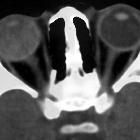morning glory disc anomaly




 nicht verwechseln mit: Morning glory sign (midbrain)
nicht verwechseln mit: Morning glory sign (midbrain)Morning glory disc anomaly (MGDA), also known as morning glory syndrome, is a rare congenital malformation of the optic nerve which is frequently associated with midline abnormalities of the brain and skull .
Epidemiology
Morning glory disc anomaly is rare and is more commonly found in females .
Clinical presentation
Patients may be initially referred for leukocoria or strabismus and present with variable visual acuity, which depends on the extent of the optic nerve anomaly. Visual field defects and enlarged blind spots are also common .
Pathology
Morning glory disc anomaly is characterized by an enlarged, funnel-shaped excavation in the optic disc, with peripapillary chorioretinal pigmentary changes and overlying central white glial tuft. The vessels are radially oriented, resembling the petals of the morning glory flower, making it challenging to distinguish the arteriolar and venous circulations .
Associations
Morning glory disc anomaly has many frequently associated features :
- ocular manifestations:
- retinal detachment: thought to arise because of the communication between the subretinal, subarachnoid, and vitreous spaces
- persistent hyperplastic primary vitreous
- congenital cataract
- nanophthalmos
- eyelid hemangioma
- drusen
- preretinal gliosis
- abnormalities of visual pathways:
- hypoplasia of the contralateral optic chiasm as a result of axonal degeneration
- optic nerve glioma
- skull base abnormalities:
- intracranial vascular malformations:
- static segmental aplasia of the circle of Willis
- moyamoya syndrome: shown to be present in up to 45% of cases
- PHACE syndrome
- neurofibromatosis type 2
Radiographic features
The diagnosis of morning glory disc anomaly is based on the clinical and fundoscopic features. However, imaging provides additional information regarding the associated ocular, midline and vascular abnormalities.
MRI
MRI is considered the imaging modality of choice .
- T1:
- a funnel-shaped morphologic pattern of the optic disc with elevation and hyperintensity of the adjacent retinal surface
- fat within the distal optic nerve sheath
- T2:
- abnormal tissue within the distal intraorbital segment of the ipsilateral optic nerve
- effacement of the subarachnoid space at that level
- discontinuity of the uveoscleral coat at the optic nerve insertion
- T1 C+ (Gd):
- enhancement of the abnormal tissue in the region of the distal optic nerve
Treatment and prognosis
As there is no definitive treatment for morning glory disc anomaly, management should focus on optimization of visual acuity and prevention of amblyopia .
History and etymology
The condition was first described in 1970 by Kindler, and the name stems from the resemblance its fundoscopic features make to the morning glory flower .
Differential diagnosis
The primary differential diagnosis is the optic nerve coloboma. Morning glory disc anomaly is almost universally a sporadic condition whereas optic nerve coloboma is commonly familial and may occur in association with multisystem congenital malformation syndromes .
Siehe auch:

 Assoziationen und Differentialdiagnosen zu morning glory disc anomaly:
Assoziationen und Differentialdiagnosen zu morning glory disc anomaly:


